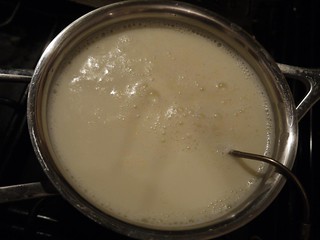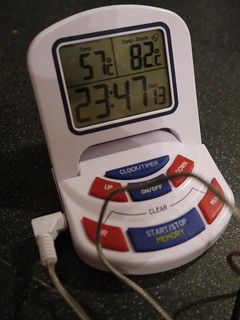It is a truth universally acknowledged that growing your own affects the way you cook and eat. In my case, it has affected the way I think more broadly, for example about reuse and recycle.
On the plot I reuse a lot of punnets, bags and all sort of food packaging, including yogurt tubs, with which I make seedlings domes. I started using them because - mostly coming in plastic 5 - they were not recyclable in our council scheme, which does only 1 and 2 (plastic bottles, basically). When I reached capacity on the plot, I got very annoyed to have to throw them in the bin.
Then I found that Rachel's used recyclable pots. Then Rachel's stopped using recyclable pots, and in any case I was so disappointed they used starch in the flavoured yogurt. Then I found that Woodland's makes lovely sheep yogurt in recyclable pots. But what if they stopped? I have had enough of unreliable supply of my favourite products - it happens a lot here in the UK: as soon as I find something I like, it disappears from the market.
I thought I would like to make my own, so I asked around and ever resourceful Carl said it would be easy peasy and shared his recipe, with which I had a few mixed results trials. Then I also had a chat with Sonia (another great source of food-related advice), and, in just over a month, I managed to come up with a recipe that worked for me, and I'm not going back to tubs!
 Trial and error is necessary, because results depend on the milk and tools you use.
Trial and error is necessary, because results depend on the milk and tools you use.I use non-homogenised, organic milk. If you can find it locally, so much the better. If you can find it in a glass jar, possibly even better.
And I process it with the kit in the picture.
Besides, you need some yogurt as a starter (after the first time, you will reserve a few spoonfuls of the previous batch). I tried several and the one I liked most was Yeo Valley Greek Natural, because it does not contain any funny stuff ("No added ingredients. No added sugar.") and because it contains
- Lactobacillus bulgaricus;
- Steptococcus thermophilus (the two yogurt bacteria); and
- Bifidobacteria (probiotics)
So, pour your milk in a thick bottom pan, plunge a food thermometer in it and place on the simmer hob at lively temperature, until it reaches a temperature around 80C.
Stir frequently to prevent a film from forming on the surface of the milk.
When it reaches temperature, if you have stirred enough, it will look slightly foamy as in the picture.

Turn the hob to the minimum and keep the temperature around 80C (give or take 2) for 8 minutes. I guess this step serves to evaporate a little bit of the water in the milk, so it gets thicker.
It is likely in the past taking the milk to boiling temperature was necessary to kill all nasties, but now it's pasteurised already.
After the 8 minutes, take off the hob and leave it alone to cool down.
The nice bacteria listed above eat and reproduce more happily in warm temperature, let's say roughly body temperature, so you need to have the milk around 40C for as long as possible.
Adding the starter, which is cold and pouring the milk in your final vessel will cool it down. So, to allow for that, the milk is ready to take out of the pan when around 55-60C.

For 1.5 l milk I use 3-4 tbsp yogurt starter, which I place in the bottom of the jar. I usually take the starter out of the fridge before starting the whole procedure and keep a room temperature for a while just to avoid temperature shocks to the bacteria.
Then I pour my warm milk over it and stir well before closing the jar.
Finally, I get out the very secret tool to perfect the recipe: an old woollen jumper.
I wrap my jar in the jumper, place it in a drought-free place in my sitting room and wait for a few hours.
If you make it in the morning, it should be thick by evening and if you make it in the evening it should be thick by morning (but I have read 3 hours might even be enough).
It will keep for a week (if you do not eat it before!), getting sourer with time.
Oh by the way, if it does not work and you do not find it thick,the cause was the temperature not being warm enough for enough time. You can heat it up in the jar to around 50C by placing in the oven (mind any plastic that might melt), and let it cool down inside.
Sometimes it comes out of the jumper with yellow residue water on top, I am not sure why, but it does not affect quality that I can tell. I had experiments in which the whole thing was watery, like diluted curdled cheese, and I strained and ate it with great pleasure....
Besides doing you good eaten as is or with cereals, it is delicious to cook curry with: tried and tested!
Are you going to have a go? Or you are an expert and have any tips? Would love to share.





.JPG)